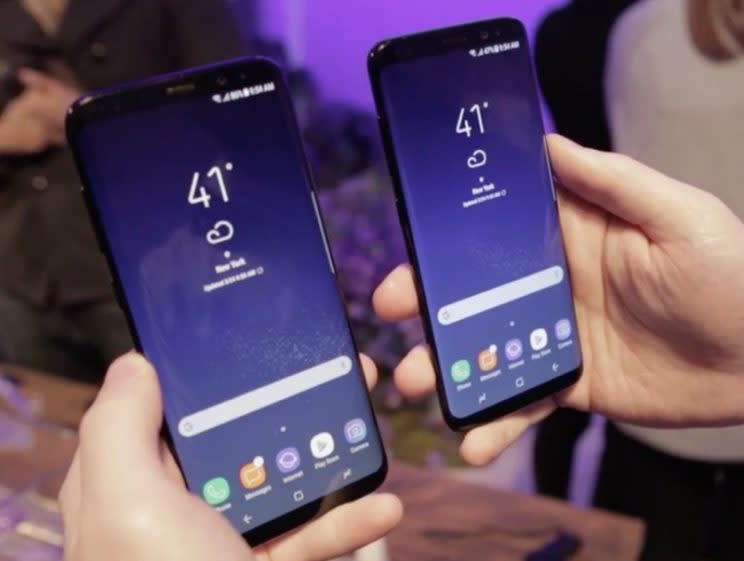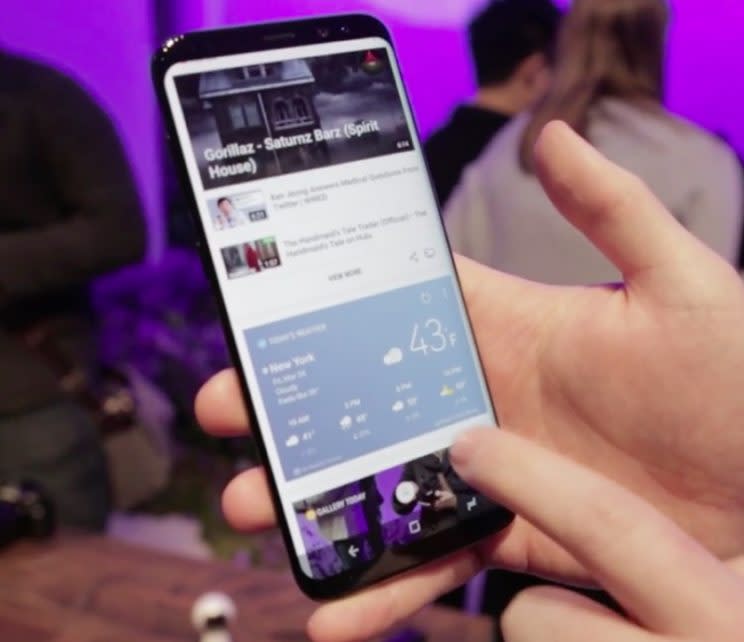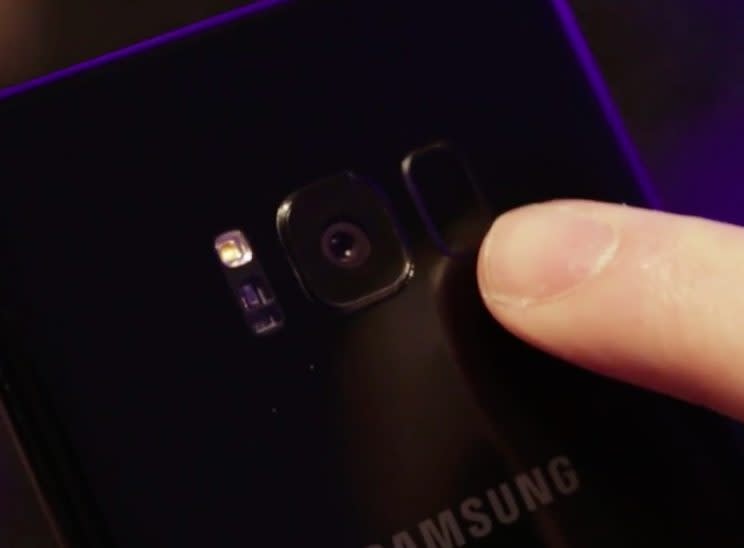Samsung Galaxy S8 and S8 Plus: Giant screens, new voice controls and no fires
Samsung had a rough 2016. Now that its Note7 has literally gone up in flames, the company needs a hit to revitalize its image. Which is where the Galaxy S8 and S8 Plus come in.
With huge, edge-to-edge screens, improved camera software and the company’s new Bixby voice assistant, the S8 and S8 Plus look like early contenders for the best smartphones of the year. But Samsung wants these handsets to be more than just another way for you to check Snapchat and jealously browse your friend’s vacation pictures on Facebook.
The company wants the S8 to serve as the cornerstone of your connected home hub, your next desktop-style computer and a gateway to the world of virtual reality. The S8 and S8 Plus are designed to be a palate cleanser for the Note7, which had to be recalled because battery and design flaws caused the phones to overheat and even sometimes catch fire.
IDC’s Ramon Llamas says if the handsets are as good as all of the leaks suggest, they should help revitalize Samsung’s image. “Samsung wants these new innovations to help push the battery debacle further and further into the rear view mirror,” he said.
Of course, it’s too early to determine if Samsung will succeed on that front. Still, after spending some time with the S8 and S8 Plus, I’m under the impression that the world’s largest smartphone maker is likely back on track.
The disappearing bezel
Since the launch of Samsung’s Galaxy Note Edge in 2015, the company has been flirting with the concept of an edge-to-edge display. The Galaxy S7 Edge came close to that with its cascading Edge displays on its left and right sides. But the S8 and S8 Plus go beyond that, pushing the phones’ panels as close to their top and bottom borders as they can go.
The result is a smartphone screen that takes up a whopping 83% of the handset’s face. This Infinity Display means Samsung can cram a bigger panel onto a device that’s roughly the same size as the previous generation S7. For the standard S8, that means a 5.8-inch screen, while the S8 Plus gets a 6.2-inch display.
To put that in perspective, Apple’s (AAPL) iPhone 7 Plus packs a 5.5-inch panel in a body that’s noticeably larger than the S8. In other words, you’re getting more bang for your buck when it comes to the S8 and S8 Plus’ screens.

Those Super AMOLED displays, known for their brilliant colors, also support HDR, or high dynamic range, content playback, meaning they provide higher contrast ratios, so blacks look darker and whites brighter.
By reducing the size of the S8 and S8 Plus’ bezels, though, Samsung left no room for physical buttons. So the company now uses digital versions of its Home, back and recent apps buttons positioned at the bottom of its screens. What’s more, Samsung has moved the phones’ fingerprint readers to their rear panels, like Google’s (GOOG, GOOGL) Pixel and LG’s G6. Unfortunately, I found the reader a bit hard to locate with my index finger, since it’s positioned so close to the S8’s camera.
Samsung has also included two additional ways to log into your phone, an Iris scanner, similar to the one found on the Galaxy Note7, and facial recognition technology. Both use the S8 and S8 Plus’ front cameras and can scan your eyes and face so quickly that it’s hard to capture the process on camera.
Let’s talk, Bixby
The S8 and S8 Plus also mark the debut of Samsung’s new Bixby voice software. The system, which I saw a brief demonstration of, is designed to let you manipulate nearly all aspects of the S8 and S8 Plus using your voice. Want to raise the display brightness? You can do that. Check the weather? You can do that, too. Cast images to your TV? Well, you get the picture.

Samsung wouldn’t say whether Bixby is a direct competitor of Google’s Assistant or Apple’s Siri, but it’s clear that’s exactly the play here. The company is fully aware that the future of computing is in AI and voice, and so it’s looking to score a piece for itself. Bixby doesn’t just let you control your phone, though. The app’s interface is accessible via a dedicated hardware button on the side of the handset and serves as a hub for Samsung’s S Health app, Facebook updates, suggested videos from YouTube and news through Flipboard.
Samsung will also soon begin integrating technology into its voice assistance from Viv, the AI company formed by the creators of Siri that the South Korean tech giant acquired in October 2015. That means Bixby will only improve in terms of capabilities as the software matures.
Still, I wasn’t able to use the software for very long, so I can’t say how well it works out of the box quite yet.
The desktop smartphone
Samsung also wants your phone to become a bigger part of your desktop workspace. To that end, the company is rolling out its new Dex dock. A small, hockey puck-style device, Dex lets you operate your handset like a tiny desktop PC.
After connecting a display, mouse and keyboard to the Dex, you plug in your S8 or S8 Plus and everything you see on your handset is available on your monitor and accessible via your mouse and keyboard just like a PC. Samsung also designed its apps so you can resize and move them around the screen like standard desktop-style programs. What’s more, you can use multiple apps at once. Samsung also says you’ll be able to access Windows 10 via a virtual machine app, though how well that will work remains to be seen.
The concept of using your smartphone as a desktop isn’t new. Microsoft offers a similar experience via its Windows Continuum feature, which turns your Windows Phone into a Windows 10-powered desktop.
What’s inside
Inside, the Galaxy S8 and S8 Plus pack virtually the same hardware. They both get octa-core processors, 4GB of RAM and 64GB of onboard storage. You can increase that to 256GB via a microSD card.
Samsung says it’s taking battery testing seriously with the S8. To that end, the company is putting its power plants through an 8-step checklist to ensure they don’t run into the same problems as the Note7’s batteries. The S8 gets a 3,000 mAh battery, while the larger S8 Plus gets a 3,500 mAh unit. Both support fast and wireless charging capabilities.

Interestingly, Samsung didn’t put much emphasis on its camera this time around. While Apple and LG offer smartphones with dual-lens shooters with optical zoom, the S8 and S8 Plus use the same 12-megapixel camera as the one found in last year’s Galaxy S7. This time, though, Samsung says it improved the camera’s software to reduce image blurring during high-speed shooting.
Samsung has yet to announce pricing or availability for the S8 and S8 Plus, but they’ll likely sell for the same price as the S7 and S7 Edge when they debuted: $670 and $790, respectively. Stay tuned for our review of both handsets in the coming weeks.
More from Dan:
Email Daniel at dhowley@yahoo-inc.com; follow him on Twitter at @DanielHowley.

 Yahoo Finance
Yahoo Finance 
